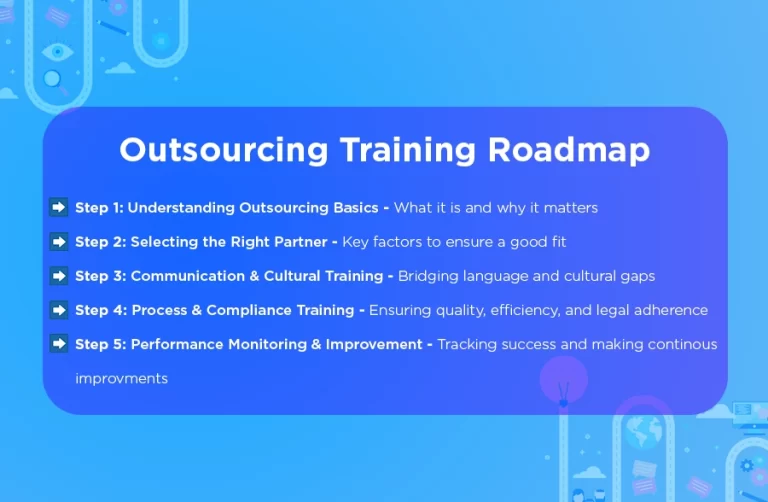Schedule a FREE call with our outsourcing expert now and get a precise quotation that meets your requirements. Don't wait - get started today!
Outsourcing can feel like handing over the keys to your business operations. Will the new team deliver? Will they understand your brand’s values? Many businesses dive into outsourcing, expecting instant results—only to face miscommunication, inefficiencies, and unmet expectations.
Here’s the truth: outsourcing success doesn’t happen by chance. It requires structured training courses to align your in-house team with external partners. Without them, you risk operational bottlenecks, inconsistent service quality, and a disconnect between your goals and the vendor’s execution.
Let’s explore why investing in training courses is the key to making outsourcing a competitive advantage rather than a liability.
Why Training Courses Matter in Outsourcing
Before exploring the specifics, it’s essential to understand why training courses play a crucial role in outsourcing success. Many SMEs assume that outsourcing is as simple as hiring a vendor and delegating tasks. However, without structured training courses, businesses can experience miscommunication, inefficiencies, and unmet expectations.
A well-designed training course gives employees the necessary knowledge and skills to manage outsourcing relationships effectively. It ensures that teams understand how to:
-
Collaborate with outsourced partners to improve workflow and efficiency.
-
Define clear expectations to align goals with external teams.
-
Implement best practices for seamless integration and communication.
Without a structured learning approach, businesses risk operational bottlenecks, inconsistent service quality, and misalignment with company goals.
Studies have shown that businesses investing in structured training programs experience significant improvements in efficiency and profitability. A 10% increase in workforce education leads to an 8.6% boost in productivity—a gain even higher than investing in new equipment.
When applied to outsourcing, training courses help businesses:
-
Strengthen vendor relationships.
-
Reduce operational errors.
-
Maintain consistent service quality.
-
Improve customer satisfaction and response times.
Without proper training courses, companies may struggle with communication breakdowns, unclear workflows, and accountability issues. Investing in structured learning ensures that outsourcing becomes a strategic advantage rather than a challenge.
Key Components of an Effective Outsourcing Training Course
Not all training courses are created equal. SMEs should look for specific components to ensure the training aligns with their outsourcing goals.
1. Identifying Tasks Suitable for Outsourcing
Before outsourcing, it’s crucial to determine which tasks can be delegated. A good training course will guide businesses in:
-
Assessing Core vs. Non-Core Activities: Understanding which tasks are essential to the business and which can be outsourced. This helps SMEs focus on their strengths while delegating time-consuming tasks to experts.
-
Evaluating Risks and Benefits: Weighing the pros and cons of outsourcing specific tasks. Training should include case studies to show how different outsourcing strategies affect business performance.
2. Creating a Comprehensive Outsourcing Plan
A well-structured plan is the backbone of successful outsourcing. Training should cover:
-
Setting Clear Objectives: Defining what the business aims to achieve through outsourcing. Whether it’s cost savings, efficiency, or scalability, clear goals help measure success.
-
Selecting the Right Partners: Criteria for choosing vendors that align with company values and goals. A good course will include guidance on conducting due diligence, from checking references to assessing service level agreements.
-
Establishing Communication Protocols: Ensuring seamless interaction between in-house teams and outsourced partners. Training should include best practices for collaboration tools, time zone management, and regular performance updates.
3. Managing the Outsourced Relationship
Once the partnership is established, maintaining a healthy relationship is key. Training should focus on:
-
Performance Monitoring: Setting up metrics to evaluate the outsourced team’s performance. This includes tracking response times, error rates, and customer satisfaction scores.
-
Conflict Resolution: Strategies to address and resolve any issues that arise. A structured approach to conflict management prevents small issues from becoming major disruptions.
-
Continuous Improvement: Encouraging feedback and progressive improvements in processes. Businesses should learn how to refine workflows based on performance reviews and market trends.
4. Ensuring Data Security and Compliance
Data protection is a critical concern in outsourcing. A strong training course should educate businesses on:
-
Understanding Compliance Requirements: Knowing industry-specific regulations, such as GDPR, HIPAA, or PCI-DSS, ensures legal and ethical outsourcing practices.
-
Implementing Security Measures: Protecting sensitive business and customer information through secure communication channels, encryption, and access controls. Training should cover how to assess a vendor’s security policies before signing a contract.
5. Training In-House Teams for Outsourcing Success
A successful outsourcing strategy involves not only external partners but also internal teams. Training should include:
-
Preparing Employees for Change: Helping staff adapt to new workflows and understand how outsourcing supports business goals. Resistance to change can impact productivity, so employees should be involved in the transition process.
-
Defining Roles and Responsibilities: Ensuring that in-house teams know how to collaborate with outsourced teams. Clear job descriptions and process documentation help avoid confusion.
Adding these elements to an outsourcing training course ensures SMEs are well-prepared for long-term success.

What to Look for in a Training Course
Not all training courses are created equal. Here’s what SMEs should prioritize when choosing one.
1. Practical, Real-World Scenarios
The best training courses use real-world examples. These scenarios help your team apply what they’ve learned in a practical setting. Look for courses that include case studies or simulations.
2. Customizable Content
Every business is unique. A one-size-fits-all approach rarely works. Choose a training course that can be tailored to your specific needs. This ensures the content is relevant and actionable.
3. Expert-Led Sessions
The quality of the trainer matters. Look for courses led by industry experts with hands-on experience in outsourcing. Their insights can make a big difference.
4. Ongoing Support
Training shouldn’t end when the course does. The best programs offer ongoing support. This could include follow-up sessions, resources, or access to a community of professionals.
Measuring the Impact of Training on Outsourcing Success
Investing in a training program for outsourcing is only the first step. To ensure its effectiveness, businesses must track measurable results. Without clear performance metrics, companies risk wasting time and resources on ineffective training. So, how can businesses evaluate the success of their training programs?
Key Performance Indicators (KPIs) for Measuring Training Success
Tracking specific KPIs helps businesses understand whether their training initiatives are improving efficiency, reducing errors, and enhancing customer satisfaction. Here are the most relevant metrics to measure:
1. Reduced Error Rates
How well does the training minimize mistakes?
-
Compare pre-training and post-training error rates in outsourced tasks.
-
Track data entry errors, customer service miscommunications, or product defects.
-
Conduct quality control audits to measure accuracy improvements.
2. Improved Turnaround Times
Are outsourced teams completing tasks faster without compromising quality?
-
Measure average task completion times before and after training.
-
Track time per ticket resolution in customer service or processing times in back-office tasks.
-
Analyze workflow efficiency improvements with time-tracking tools.
3. Increased Customer Satisfaction Scores (CSAT)
Are customers happier with the service quality post-training?
-
Monitor CSAT scores from customer feedback.
-
Track improvements in Net Promoter Score (NPS) and customer complaints reduction.
-
Use post-training surveys to gauge customer sentiment.
4. Higher First-Call Resolution (FCR) Rates
Are customer issues being resolved in the first interaction?
-
Track the percentage of issues resolved in the first customer contact.
-
Compare pre-training vs. post-training resolution rates.
-
Identify common challenges that need additional training.
5. Employee Retention & Satisfaction
Are outsourced employees staying longer and performing better?
-
Measure attrition rates among outsourced teams.
-
Conduct post-training employee surveys to assess engagement.
-
Track improvements in team collaboration and morale.
Train Smarter, Outsource Better
Outsourcing should drive growth, not create roadblocks. Without structured training, businesses risk communication breakdowns, inefficiencies, and inconsistent results. A well-designed training program ensures your teams—both in-house and outsourced—work seamlessly toward shared goals.
At Magellan Solutions, we don’t just provide outsourcing services; we equip teams with the right knowledge and skills to maximize efficiency and performance. Our expert-led call center training Philippines programs and tailored outsourcing solutions help businesses achieve consistency, productivity, and long-term success.
Take control of your outsourcing strategy. Let’s build a smarter, more effective team together!












